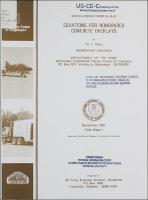Please use this identifier to cite or link to this item:
https://hdl.handle.net/11681/10269| Title: | Equations for nonbonded concrete overlays |
| Authors: | United States. Army. Corps of Engineers. Huntsville Division Chou, Yu T. |
| Keywords: | Concrete coatings Concrete expansion Concrete retraction Concrete overlays Mathematical models Numerical models |
| Publisher: | Geotechnical Laboratory (U.S.) Engineer Research and Development Center (U.S.) |
| Series/Report no.: | Miscellaneous paper (U.S. Army Engineer Waterways Experiment Station) ; GL-85-25. |
| Description: | Miscellaneous Paper Abstract: The nature of the design equations for the nonbonded concrete overlays currently used by the US Army Corps of Engineers was examined, and the original source of the equation was also examined. Using simple mechanics, it was found that the existing equation is true when the condition E₁h₁= E₂h₂is true, where E₁, E₂, h₁, h₂ are the elastic modulus of the concrete overlay and the base slab, and the thickness of the overlay and the base slab, respectively. Where E₁ is assumed to be equal to E₂, the existing equation is true when h₁= h₂ is true. Also using simple mechanics, new overlay equations were developed which are suitable for different thicknesses and elastic properties in the overlay and base concrete slabs. The difference in the computed overlay thickness between the new and existing equations is not large when the overlay thickness is equal to or greater than the base slab. The difference can become excessive when the overlay thickness is much less than that of the base slab. The new equations were compared with the finite element computer program for concrete overlays with various combinations of slab thickness, elastic property, and subgrade modulus. The comparisons were very favorable, indicating that the overlay equations developed in this report are analytically correct. The validity of the equations was also examined using the field full-scale accelerated traffic tests on concrete overlays. It was difficult to judge whether the new equations are superior to the existing equation. This conclusion was expected because for all the seven test sections analyzed, the overlay thicknesses were either equal to or greater than those of the base slabs. It is recommended that the existing design equations for nonbonded overlays not be replaced by the new equations. The new equations are suggested for use when either the overlay is nearly equal to the base slab but the elastic modulus of the base concrete is much larger than that of the overlay concrete or when the overlay is thinner than the base concrete slab. This is particularly true in the latter case when the modulus of the base is larger than that of the overlay concrete. In these cases, the new equation would give thicker overlays than the existing equation. |
| Rights: | Approved for public release; distribution is unlimited. |
| URI: | http://hdl.handle.net/11681/10269 |
| Appears in Collections: | Miscellaneous Paper |
Files in This Item:
| File | Description | Size | Format | |
|---|---|---|---|---|
| MP-GL-85-25.pdf | 5.13 MB | Adobe PDF |  View/Open |